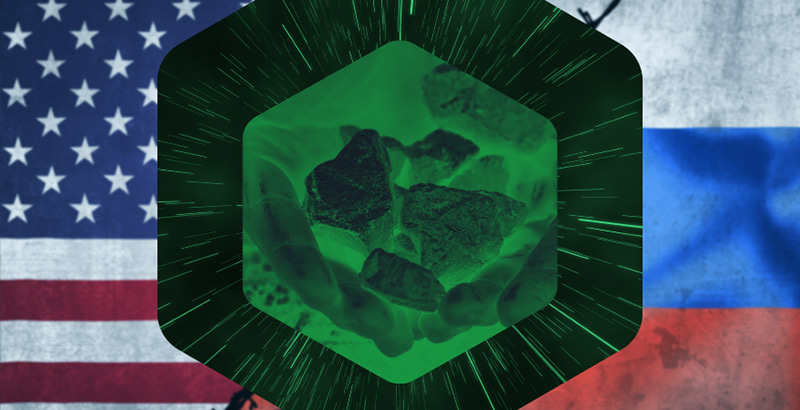By Grant Anderson
August 24, 2022
In the six months since Russia invaded Ukraine, a litany of follow-on effects from the conflict have reverberated throughout the globe, many of which could achieve permanence as a new norm or standard. These effects are as diverse as they are numerous. The war has challenged long-standing assumptions about European energy policy and food security. It has reinvigorated discussions about the future of NATO. And it has further stressed supply chains in areas already whipsawed due to the pandemic, while raising future concerns about the sourcing of key minerals for use in modern manufacturing.

Of mounting concern is the sourcing and mining of Rare Earth minerals – also commonly known as Rare Earth Elements, or REEs for short. These 17 specific elements aren’t exactly “rare” per se but are often difficult to access and extract. Additionally, the mining of REEs in the U.S. – which itself is “rare” – ensures that most of the REEs used in America are mined abroad and imported. Beyond anything else, this is a supply chain concern that should be of top interest to policymakers at the national level, particularly as we work to reduce vulnerabilities in our sourcing of materials for everything from common domestic uses to national security. And as the war between Russia and Ukraine grinds on, disruptions in things like REEs will only grow in importance.
The list of applications that use REEs is considerable and includes everything from next-generation batteries and cellphones to cameras, computers, and semiconductors. REEs are used to build guidance and control systems, lasers, radar and sonar. Stealth and night-vision technologies also rely on REEs as core elements. They are also increasingly used in energy production.
REEs are vital to the space industry
Of specific note, REEs are vital to the space industry, given the criticality of REEs to the manufacture of high-technology components used in everything from launch vehicles to national defense and commercial communication and observation satellites. It might not be a stretch to suggest that we wouldn’t have a space industry if it weren’t for REEs.
Without REEs, we probably wouldn’t have advanced cameras on satellites or satellite communications systems, advanced batteries to power spacecraft, high-resolution display screens or microchips in modern computers, solar panels and cells, specialized coatings on optical glass or thermal control systems, fiber optics or temperature sensors. REEs are essential to all of these components and uses. As technology evolves — as solutions become smaller, lighter and more efficient (an enduring requirement for space platforms) — these elements will only become more imperative.
A central concern is that while America imports most of our REEs from China, disruptions in the global supply chain in one area – like Russia or Ukraine – can reverberate throughout the global economy and may eventually circle around to affect our supply access indirectly. In fact, we depend on China for 31 of 35 strategic materials, eight of which are REEs, identified by the U.S. government as imperative to national defense; more importantly, 14 of those specific elements are not found in the U.S, and as of right now none are processed in the U.S. – meaning we have to go abroad for usable product.
But as long as there is competition for key resources, access to those resources or elements isn’t always guaranteed. The rapidly changing supply and demand dynamics in the global liquefied natural gas market – which have seen gas shipments re-routed from Asia to Europe – clearly shows that things aren’t always locked in place. In this regard, reliable and steady access to REE sources could be vulnerable to the same competitive market forces and fluctuations. And by extension, bottlenecks in sourcing REEs used to produce space technologies could stimulate a chain of complications, like delays in program delivery.
Of course, Russia’s vast mineral wealth is well known – which is now constricted for world export due to sanctions. But Ukraine, long been considered an agricultural “breadbasket,” has also become increasingly recognized for its mineral abundance. For example, Ukraine is estimated to hold upwards of 500,000 tons of lithium oxide — a core mineral for modern batteries. Ukraine also has major energy deposits and precious metals such as Titanium.
Challenges ahead
With the war physically devastating Ukraine, and economically truncating Russian connectivity to world markets, the impact of these developments on the global supply of crucial raw materials must be taken seriously. In fact, before Russia invaded Ukraine, market analysts were already warning of the potential impact of war on the global semiconductor market, suggesting that chip prices could spike several hundred times over due to REE sourcing; market research groups indicated that 35% of U.S.-bound palladium comes from Russia. Ukraine also provides the bulk of U.S. semiconductor-grade neon supplies.
Navigating this space may continue to be tricky, and policymakers in Washington should be mindful of these issues when they forge policy and strategy. This is especially true as we press forth on a renewed commitment to our space program, as the U.S. commercial space sector blooms and strives toward world-leading achievement, and as we modernize our national defense infrastructure (including national security space infrastructure) to meet the defense challenges of the 21st century.
Over the long term, it could be very difficult for Russia to restore her place on the planet as a responsible – never mind accepted – state. Much of the world continues to be unified in opposition to Russia over the Ukraine invasion and the longer this conflict drags out, the harder it will be for Russia to rebound from pariah status. Frankly, it may not occur in our lifetimes. At the same time, the war’s impact on the global economy will be lasting and profound. Industries like aviation, defense, and space — where maintaining the technical edge is possible only with advancing engineering, precision manufacturing, and highly prized resources with special properties — may be disproportionately affected.
It is for these reasons and more that we need to get serious about rebuilding U.S. sources and processing facilities for the most precious natural minerals, including Rare Earth Elements. As we work to expand our presence in space for commercial, civil and national security purposes, we need to do everything we can to buttress ourselves against the ripple effects on the global supply of essential raw materials from tragedies like Russia’s war on Ukraine.
Article courtesy of SpaceNews
https://spacenews.com/op-ed-the-rare-earth-ripple-effect-of-russias-war-on-ukraine/
